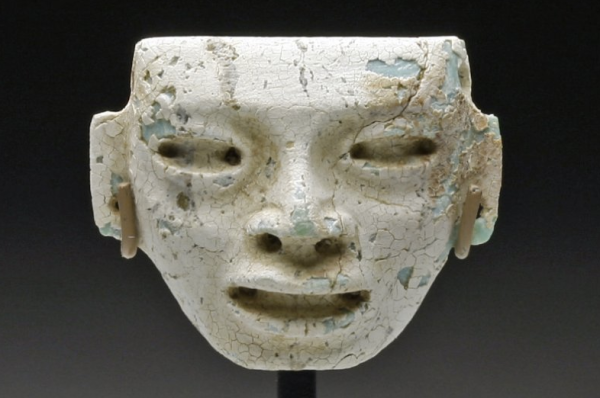Provenance Puffery at upcoming Pre-Columbian art auction

Pre-Columbian, Eastern Mexico, Ca 200 to 600 CE. Carved stone head, in what looks to be turquoise, now covered in deep white caliche (hardened deposit of calcium carbonate); with deep set, almond-shaped eyes, large lips open as if speaking and drilled ears. Custom stand. 20mm x 23mm.
PROVENANCE: Ex-prominent Chicago, IL Collection acquired from Throckmorten (sic) Fine Arts.
Authenticity Guaranteed
Nearly every one of the 148 items in the February 1, 2013, Pre-Columbian art auction by Antiquities-Saleroom has no dated provenance despite a press release that proclaims: “Provenance and pedigree combine to form a compelling reason to bid in Antiquities Saleroom’s Feb. 1 sale of premier Pre-Columbian art.”
In the entire sale, only six works have a dated provenance, of which four are pre-1970.
Nevertheless, the press release later notes: “Most pieces in the auction boast provenance from distinguished sources, including Sotheby’s, Christie’s, the Denver Art Museum and even Andy Warhol, who reportedly had a discerning eye for antiquities.”
Yet, “most pieces in the auction boast” no dated provenance – more than 95%.
The online catalogue is thick with assurances: “Authenticity Guaranteed” “Authenticity Guaranteed!” and “Authenticity Unconditionally Guaranteed!” (it’s unclear if this means there’s a hierarchy in authenticity from no exclamation point to exclamation point and finally “unconditionally” with an exclamation point – most items in the sale carry the basic level “Authenticity Guaranteed”).
Moreover, the section labeled “provenance” is occasionally reserved for some amusing editorializing:
Lot 2: Pre-Coumbian, Mochica Culture , North Coast Peru, ca. 100-400 CE. Portrait style face mask.Provenance: Ex-Robert Sonin Private Collection (most famous gold authenticator in US!).
Lot 23: Pre-Columbian, Sican – Chimu Culture , North Coast Peru, ca. 800-1000 CE. Important pair of large gold Royal Ear Spools. Provenance: Ex-Fred Leighton Collection, New York City, NY (famous Madison Ave jeweler to the stars).
Lot 88D: Pre-Columbian, Jalisco, West Mexico, Ca 200 BCE – 200 CE. Fine, thin-walled “squeezed” terracotta vessel. PROVENANCE Ex-prominent Los Angeles, CA Collection, ex-Proctor Stafford Collection. Stafford’s collection was the start of The Los Angeles Museum of Art’s (LACMA) Pre-Columbian department. His collection was considered as one of the biggest and best among collectors worldwide. In fact, his pieces were so in demand LACMA loaned them out to other Museums nationwide!
This whole thing, with it’s incomplete provenances and amusing misspellings (including this in Lot 1: “Provenance: Ex-private Los Angels, (sic) CA collection”), would be laughable except for one major issue – “most pieces in the auction boast” no dated provenance – more than 95%!
And that’s worthy of an exclamation point.
Great post, Nord. I might just add that the word “provenance” has a real meaning which is completely ignored by the auction house: “the place where the object emerged from the ground.” That’s it. Not “the person or institution who owned it for a while,” which is summed up in the phrase “collection history” instead.
When it comes to antiquities, most museums are happy to fudge the difference between “provenance” and “provenience,” the latter of which means “the place where the object was made.” So the Getty or Met will say that a black-figure vase is “From Athens,” which is true in the sense of provenience, but given that such vases were exported all over the Mediterranean and even to trans-Alpine Europe in antiquity, is of little to no use as provenance. The public doesn’t know there’s a difference, so the museum appears to be transparent.
Hey Justin- Where are you getting these definitions? “Provenance” comes from the French word ‘provenir’ = ‘to come from’. The problem is that the word itself is intrinsically ambiguous; it legitimately means both “archaeological findspot” and “ownership history”. [In fact, in museum contexts, the “ownership history” meaning is far more common, and probably a lot older too.] The problem is that when it comes to antiquities (more so than for, say, early modern oil paintings) there is a lot at stake in the distinction between findspot and ownership history. It’s not that museums are ignoring the one “real meaning” of the word; they are, rather, taking advantage of the word’s real ambiguity. Clemency Coggins, Ken Lapatin and others have argued that those of us in the field should try to force a distinction, and use “provenience” when we mean archaeological findspot, but this suggestion has not been widely taken up. Chippindale & Gill have argued instead that we not use the term provenance at all, but rather spell out “archaeological findspot” or “ownership history” (or “place of manufacture”).
Elizabeth — I’m taking the definitions from Rip Rapp and his book on geoarchaeology. Let me amend my statement to say instead that quibbling over the precise word you use for “place for where something is found” or “place where something is made” or “person or institution who owned something” is not important (I might even say it’s just plain pedantic) compared to making a distinction between those things in the first place. If museums and auction houses would do that, they could start to claim that they take the problem seriously. When the Cleveland Museum (of all places) names its new cafe “Provenance,” we know that they don’t take it seriously.
http://www.merriam-webster.com/dictionary/provenance
prov·e·nance
noun \ˈpräv-nən(t)s, ˈprä-və-ˌnän(t)s\
Definition of PROVENANCE
1: origin, source
2: the history of ownership of a valued object or work of art or literature
See provenance defined for English-language learners »
Examples of PROVENANCE
Has anyone traced the provenances of these paintings?
The artifact is of unknown provenance.
Origin of PROVENANCE
French, from provenir to come forth, originate, from Latin provenire, from pro- forth + venire to come — more at pro-, come
First Known Use: 1785